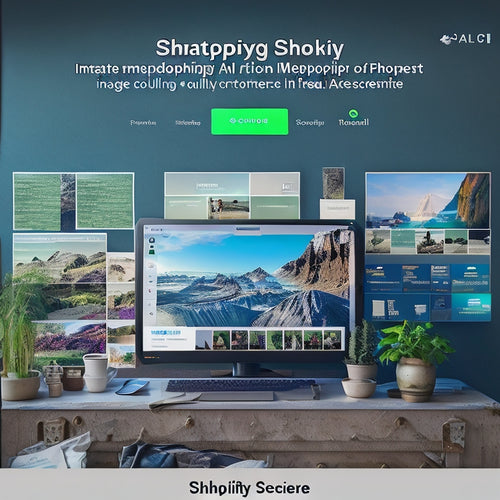
Enhanced Customer Engagement: Targeting Segmentation Strategies
Share
You can boost customer engagement by adopting targeted segmentation strategies. By recognizing the importance of customer segmentation, you'll tailor marketing efforts to specific groups, increasing the likelihood of resonating with unique needs and preferences. Demographic segmentation helps you drill down into age groups, occupations, and educational backgrounds, while geographic and psychographic approaches allow you to tap into regional cultural norms and lifestyle choices. By combining these strategies, you'll create personalized campaigns that speak directly to your customers' needs. Now, get ready to uncover more precision-driven approaches to drive engagement and loyalty to the next level.
Key Takeaways
• Recognize the importance of customer segmentation to tailor marketing strategies and increase engagement and loyalty.
• Use demographic segmentation to craft marketing messages that resonate with specific age groups, occupations, and educational backgrounds.
• Apply geographic and psychographic approaches to create campaigns that appeal to regional cultural norms, lifestyle choices, and personality traits.
• Utilize technographic and behavioral segmentation to pinpoint customers based on tech savviness and purchase behaviors, and offer personalized recommendations.
• Analyze age, gender, and occupation insights to create highly targeted marketing campaigns that speak directly to customer needs and preferences.
Understanding Customer Segmentation
By recognizing the importance of customer segmentation, you can tailor your marketing strategies to specific groups, increasing the likelihood of resonating with their unique needs and preferences.
This approach allows you to identify and cater to distinct customer preferences, ultimately driving engagement and loyalty. The benefits of segmentation are undeniable, as it enables you to create targeted campaigns that resonate with your audience, rather than adopting a one-size-fits-all approach.
Demographic Segmentation Strategies
You can tap into the power of demographic segmentation by drilling down into specific age groups, occupations, and educational backgrounds to craft marketing messages that resonate with your target audience. This strategic approach enables you to create personalized campaigns that speak directly to their needs and preferences.
By leveraging demographic targeting, you can tailor your marketing efforts to effectively engage with distinct customer segments. For instance, you can develop marketing messages that cater to young professionals, stay-at-home parents, or retirees, each with unique needs and interests.
Geographic and Psychographic Approaches
Geographic segmentation strategies allow companies to tailor their marketing efforts to specific regions, cities, or even neighborhoods, ensuring their messages resonate with local customers and address their unique needs. By considering regional differences, you can avoid marketing missteps and create targeted campaigns that speak to the local culture.
For instance:
-
Cultural preferences: Tailor your marketing to regional cultural norms and values.
-
Lifestyle choices: Target customers based on their lifestyle, such as urban vs. rural living.
-
Personality traits: Create campaigns that appeal to the personality traits common in a region.
- Emotional connections: Use emotional connections to create a sense of belonging and community.
Technographic and Behavioral Segmentation
As companies refine their targeting strategies, they're turning to technographic and behavioral segmentation to pinpoint customers based on their tech savviness and purchase behaviors, revealing new opportunities for personalized marketing and enhanced customer experiences.
You can leverage technographic segmentation to identify customers who are most receptive to tech-savvy promotions, tailoring your marketing efforts to their preferences. By analyzing behavioral data, you can create personalized recommendations that resonate with customers, increasing the likelihood of repeat purchases and loyalty.
This fusion of technographic and behavioral segmentation enables you to craft targeted campaigns that speak directly to your customers' needs, driving engagement and retention. By adopting this data-driven approach, you'll reveal new avenues for growth and customer satisfaction.
Age, Gender, and Occupation Insights
By analyzing age, gender, and occupation insights, companies can reveal valuable customer segmentation strategies that drive targeted marketing campaigns and product promotions tailored to specific demographics. This helps you understand your customers' needs and preferences, ensuring a more personalized experience.
Here are four ways to leverage age, gender, and occupation insights:
-
Age-specific preferences:
Tailor marketing tactics to specific age groups, such as offering discounts to seniors or promoting trendy products to Gen Z. -
Gender-targeted promotions:
Create gender-specific marketing campaigns, like promoting beauty products to women or tech gadgets to men. -
Occupation insights:
Offer occupation-specific products or services, like software solutions for professionals or ergonomic furniture for office workers.
-
Demographic-based targeting:
Combine age, gender, and occupation insights to create highly targeted marketing campaigns that resonate with your audience.
Location, Marital Status, and Hobbies
You can further refine your customer segmentation strategies by examining location, marital status, and hobbies, which provide valuable insights into individual preferences and lifestyle choices.
By considering regional preferences, you can tailor your marketing efforts to specific geographic areas, ensuring your message resonates with local customers.
Marital insights can help you target couples or singles with relevant products and services, increasing the likelihood of conversion.
Meanwhile, understanding hobbies allows you to connect with hobbyist communities and create targeted campaigns that speak directly to their interests.
Lifestyle, Purchase, and Loyalty Analysis
Leveraging lifestyle, purchase, and loyalty analysis enables businesses to pinpoint high-value customer segments, tailor marketing strategies, and drive long-term growth. By examining lifestyle trends, you can identify patterns that influence purchasing decisions. This insight helps you create targeted campaigns that resonate with your audience.
Here are four key benefits of lifestyle, purchase, and loyalty analysis:
-
Identify high-value customers: Analyze purchase behavior and loyalty program participation to identify customers who drive revenue and loyalty.
-
Personalize marketing: Tailor marketing campaigns based on lifestyle trends, purchase behavior, and loyalty rewards to increase engagement and retention.
-
Optimize loyalty programs: Develop loyalty programs that reward high-value customers, increasing loyalty and retention.
- Improve customer experience: Use data-driven insights to create personalized experiences that meet customers' unique needs and preferences.
Effective Segmentation for Engagement
To maximize customer engagement, effective segmentation strategies involve dividing your customer base into distinct groups based on their unique characteristics, behaviors, and preferences. By doing so, you can tailor your engagement tactics to resonate with each segment, fostering a deeper connection with your customers.
Alignment of segmentation with customer interactions is vital, as it enables you to develop personalized experiences that drive loyalty and retention. The personalization impact of segmentation is significant, allowing you to craft targeted marketing campaigns that speak directly to each group's needs and desires.
Frequently Asked Questions
How Often Should Customer Segmentation Strategies Be Re-Evaluated?
You should re-evaluate customer segmentation strategies annually to guarantee alignment with shifting market trends, while making real-time adjustments as needed to stay agile and responsive to emerging customer needs and preferences.
What Are the Common Mistakes in Implementing Customer Segmentation?
You must avoid common segmentation pitfalls, such as poorly defined customer targets, inadequate data, and incomplete analysis, which can lead to misguided marketing efforts and decreased customer satisfaction.
Can Customer Segmentation Be Used for B2B Marketing as Well?
You can apply customer segmentation to B2B marketing by identifying decision-maker personas, tailoring personalized messaging, and leveraging firmographic data to create targeted campaigns that drive engagement and conversions.
How Does Customer Segmentation Impact Data Privacy and Security?
You must weigh customer segmentation's benefits against data privacy and security risks, ensuring you balance personalization with robust data protection measures to safeguard sensitive information and maintain customer trust.
What Is the Ideal Ratio of Segmentation to Overall Marketing Budget?
You're trying to 'cut to the chase' and determine the best ratio of segmentation to overall marketing budget. Choose an efficient allocation of 20-30% for segmentation, ensuring its effectiveness without breaking the bank.
Related Posts
-

What's the Secret to Selling Digital Products Successfully?
You're about to uncover the vital elements that set successful digital product sellers apart from the rest. To sell d...
-

Is Making Shopify Apps Profitable
This article examines the profitability of creating Shopify apps. It discusses the benefits of Shopify apps and prov...
-

How Do I Choose a Shopify App
The selection of a suitable Shopify app is a crucial decision for individuals seeking to enhance their e-commerce ca...


